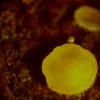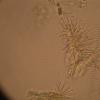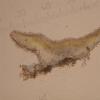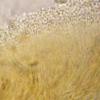
15-12-2025 15:48
 Danny Newman
Danny Newman
Melanospora cf. lagenaria on old, rotting, fallen

15-12-2025 15:54
 Johan Boonefaes
Johan Boonefaes
Unknown anamorph found on the ground in coastal sa

15-12-2025 21:11
 Hardware Tony
Hardware Tony
Small clavate hairs, negative croziers and IKI bb

15-12-2025 07:09
 Danny Newman
Danny Newman
indet. Rutstroemiaceae sp. on unk. fallen leavesMc

15-12-2025 07:05
 Danny Newman
Danny Newman
Pseudosclerococcum golindoi (det: Zotto)near Cosb

15-12-2025 11:49
 Danny Newman
Danny Newman
ITS sequences from the following two collections B

15-12-2025 12:34
 Danny Newman
Danny Newman
indet. Rhytismataceae on oak leafnear Purchase Roa

09-12-2025 12:06
 Andgelo Mombert
Andgelo Mombert
Bonjour,Je recherche l'article concernant Hypobryo
anamorphe ?
michel hurtu,
22-02-2009 15:15
Je pensais avoir ramassé un joli asco vert, d'1 mm de diamètre, mais la micro ne montre pas d'asques ni paraphyses etc...
En grattant l'endroit suposé de l'hymenium que des myriades de petites spores(?) rondes de 1 à 2 mu .
Peut être un anamorphe ou un ......?mycètes.
une idée?
amitiés
michel hurtu.
Christian Lechat,
22-02-2009 16:10

Re:anamorphe ?
on pourrait voir une coupe?
Amitiés,
Christian
Amitiés,
Christian
Alain Delannoy,
22-02-2009 17:23
Re:anamorphe ?
Le support ?
michel hurtu,
22-02-2009 19:15
Re:anamorphe ?
Une petite branche morte de pin ,noir ou sylvestre (il y a les 2 dans le secteur) sous une litière de graminées .
Christian Lechat,
22-02-2009 19:25

Re:anamorphe ?
Sur la première image les conidiomes sont jaunes, donc il s'agit peut-être de Pycnidiella resinae
Amitiés,
Christian
Amitiés,
Christian
Christian Lechat,
22-02-2009 19:31

Re:anamorphe ?
j'ai oublié de dire qu'il peut aussi s'agir de Biatorella resinae parasité par autre chose, il faudrait voir les conidiophores de plus près.
Alain Delannoy,
22-02-2009 20:02
Re:anamorphe ?
Bonsoir,
Pardon pour la brutalité de ma question mais je suis allé trop vite dans ma manipulation...
Je pensais aussi à la résine, mais il devrait y avoir des asques si c'est Biatorella !
Amicalement,
Alain
Pardon pour la brutalité de ma question mais je suis allé trop vite dans ma manipulation...
Je pensais aussi à la résine, mais il devrait y avoir des asques si c'est Biatorella !
Amicalement,
Alain
michel hurtu,
22-02-2009 21:05
Hans-Otto Baral,
23-02-2009 14:00

Re:anamorphe ?
Huiiii! This "discomycete" bothers me since a long time. I still consider it to be the anamorph of a not further known helotialen discomycete, but a relation to Sarea cannot be excluded.
During my revision of type material of "Orbilia" species I found a name for it:
Orbilia crocina (Mont. & Fr.) Sacc., Syll. Fung. 8: 632 (1889)
≡ Peziza crocina Mont. & Fr., in J.P.F.C. Montagne, Ann. Sci. nat., Ser. 2, 5: 289 (1836) [non Peziza crocina Berk. & Curt. 1868, = Calycella crocina (Berk. & Curt.) Dennis]
The fungus is mitosporic, having a gelatinised excipulum, narrow phialides in a palisade, and subglobose conidia measuring 1.8-2.2 x 1.5-1.9 µm. Although the excipulum looks similar as in Bisporella, it is probably not the same as this Calycella crocina.
It seems strange that this probably not rare species seems totally neglected in the literature. Montagne's description appears to be erroneous concerning the microdata, describing asci with numerous globose spores which easily "s'échappent.". Perhaps Montagne saw the teleomorph which actually sounds like Sarea resinae. But the anamorph of Sarea forms globose pycnidia without a hymenium. So it would be a good idea to compare more thoroughly the Sarea anamorph with this.
I attach Montagne's description.
Zotto
During my revision of type material of "Orbilia" species I found a name for it:
Orbilia crocina (Mont. & Fr.) Sacc., Syll. Fung. 8: 632 (1889)
≡ Peziza crocina Mont. & Fr., in J.P.F.C. Montagne, Ann. Sci. nat., Ser. 2, 5: 289 (1836) [non Peziza crocina Berk. & Curt. 1868, = Calycella crocina (Berk. & Curt.) Dennis]
The fungus is mitosporic, having a gelatinised excipulum, narrow phialides in a palisade, and subglobose conidia measuring 1.8-2.2 x 1.5-1.9 µm. Although the excipulum looks similar as in Bisporella, it is probably not the same as this Calycella crocina.
It seems strange that this probably not rare species seems totally neglected in the literature. Montagne's description appears to be erroneous concerning the microdata, describing asci with numerous globose spores which easily "s'échappent.". Perhaps Montagne saw the teleomorph which actually sounds like Sarea resinae. But the anamorph of Sarea forms globose pycnidia without a hymenium. So it would be a good idea to compare more thoroughly the Sarea anamorph with this.
I attach Montagne's description.
Zotto
michel hurtu,
23-02-2009 20:31
Re:anamorphe ?
dear Zotto,
many thanks for your very interesting answer,a passionating story worth to be followed...
Nice to hear from you soon.
Michel Hurtu
many thanks for your very interesting answer,a passionating story worth to be followed...
Nice to hear from you soon.
Michel Hurtu







